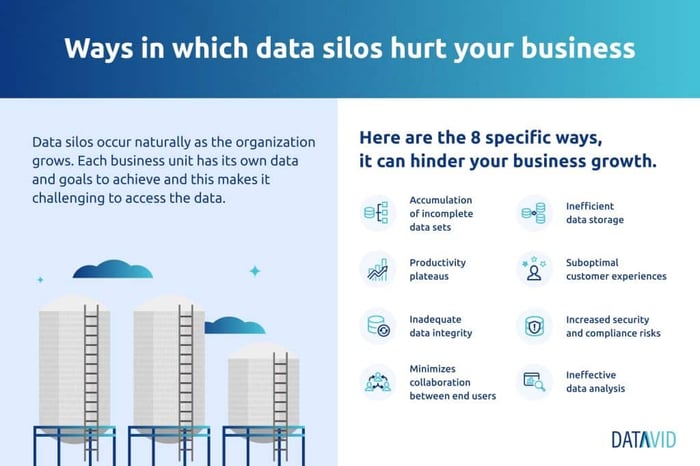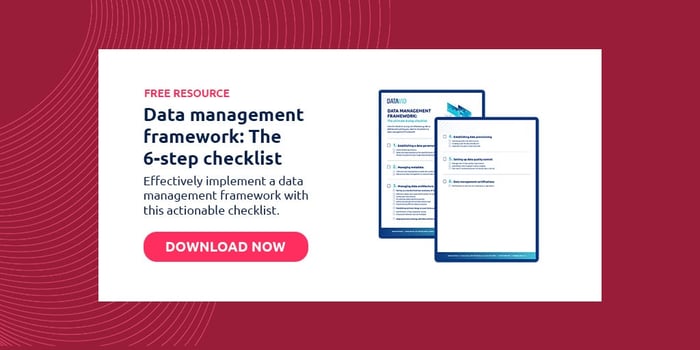4 minute read
Here are 8 reasons why data silos are problematic
Why are data silos problematic for entreprises looking to get the most of their data? Here are 8 reasons why (and how to fix them).
Table of contents
Data silos introduce significant inefficiencies in organizations. They accumulate in departmental software, preventing other departments from accessing that data.

Siloed data may not seem to be problematic at first, but isolated data often bar collaboration and information-sharing.
Data silos can damage data integrity and make it difficult for your business to develop.
What are data silos?
Data silos are stores of data that don’t link to others within your IT infrastructure, or any other department in your organization.
Siloed data is often stored in a standalone system and is usually incompatible with other data sets. This makes it challenging for users across your organization to access and use the data.
Data silos may have cultural, organizational, and technical roots.
They often emerge naturally in large organizations since separated departments operate independently and have their own goals and IT budgets.
That doesn’t mean that smaller organizations are spared –any organization can end up with data silos if they lack a well-planned data management strategy.
8 Reasons why data silos are problematic for your business
Data silos hamper business operations as well as data analytics initiatives supporting them.
They limit the ability of executives to leverage data to make informed business decisions. They also prevent other workers from accessing relevant information that can help them accomplish their tasks efficiently.

Here is an outline of the specific ways data silos can harm your business:
1. Accumulation of incomplete data sets
Data silos lock away data from users who don’t have access to them. Because of this, business decisions aren’t based on all the available data, resulting in flawed decision-making.
Siloed data hinders efforts to build data warehouses and data lakes that integrate different data sets for business intelligence and data analysis.
2. Productivity plateaus
Isolation of data within individual departments and teams kills productivity.
Users who need data outside their range must first identify the teams that own the data and then request permission to access the data before they can finally analyze it for their purpose.
Searchability and discoverability aren’t hallmarks of data silos. By the time a user completes those steps, the data may no longer be valid, and they’ll have to begin the process again.
Siloed data also cause productivity problems through duplication of efforts due to a lack of information sharing and task coordination.
3. Inadequate data integrity
Given that silos essentially store fragmented data, establishing enterprise data governance is impossible.
When there aren’t any principles guiding data use and sharing, each department within an organization will map out its own data management strategy.
Additionally, individual users are free to create micro-data silos within Microsoft Excel, Google Drive, and their PCs and other mobile devices. This makes it difficult to uphold data integrity.
4. Less collaboration between end users
When data is isolated in silos, the opportunities for data sharing and collaboration among users in different departments are reduced. It’s difficult for people to work together effectively when they don’t have visibility into siloed data.
Teams working on an independent initiative may miss vital data streams or accidentally integrate similar data sets that should be separate. They may even end up working with an old version of the same data.
When teams only have access to specific data, it results in the development of a “stay out of my way” mentality and hyper-focus on the individual instead of organizational goals.
Without the free flow of information and collaboration, achieving organizational goals or a shared vision is next to impossible.
5. Inefficient data storage
There is an overlap in the data that users require to do their jobs. When every person that uses the same data set stores the information in their data silos, storage space is wasted.
Siloed environments require more human resources and technology (i.e., data analysts, data stewards, and specialized tools) compared to a data lake with a proper organization or a centrally managed enterprise data warehouse.
6. Suboptimal customer experiences
Lack of access to the right information and reduced productivity ultimately impacts customer satisfaction. Your customers have several touchpoints with your business during their buyer journey.
These may include marketing and sales communication, website and social visits, and chats with support and billing.
When all this information is stored in different silos, it can present significant challenges, especially for your marketing operations.
Studies have shown that 47% of marketers consider data silos to be the primary reason why they don’t have an accurate view of the customer journey. This makes it difficult for organizations to provide excellent customer experience.
7. Security and compliance risks
Businesses with siloed data find it difficult to set up a comprehensive and effective data governance framework that can keep them safe from data breaches and cyber threats.
Such businesses are at high risk of failing to comply with data privacy regulations. Data silos limit an organization’s ability to identify events that could lead to violations of data privacy regulations.
8. Ineffective data analysis
Data analysis typically stores information separately. This presents a challenge when performing business analytics.
Inconsistent data needs to be standardized and transformed before it can provide useful insights and value to your organization.
This means that siloed data will either not get used entirely or will be used later on when it’s not as valuable.
Datavid can solve your data silo problem
Organizations often spend a lot of money on different SaaS providers, on-premise solutions, and other data stores that don’t talk to each other. Datavid Rover solves this problem while reducing the costs of implementing an enterprise solution.
Here are some of the things you can expect from Datavid Rover:
- Data ingestion: Continuous data integration and processing in real-time from dozens of sources relevant to your business.
- Data mining: Extract real-world information from your data with built-in Natural Process Language.
- Data curation: Easily curate information to filter out sensitive data and keep analysts focused.
- Data discovery: Discover your organization’s best knowledge with an interface that employees will want to use.
Eliminating data silos will not only improve collaboration across teams within your enterprise but also the overall decision-making process. Let’s get started.
Frequently asked questions
Data silos are problematic because they create barriers and inefficiencies in accessing and utilizing data. They lead to fragmented information, lack of data visibility, duplication of efforts, and hinder collaboration across teams and departments. Data silos limit the ability to gain holistic insights, make informed decisions, and leverage the full potential of data-driven technologies.
An example of a data silo is when different departments within an organization maintain separate databases or systems that store and manage their own specific data, resulting in isolated pockets of information that are not easily accessible or shared with other departments.
The three types of silos are departmental silos, system silos, and data silos.




